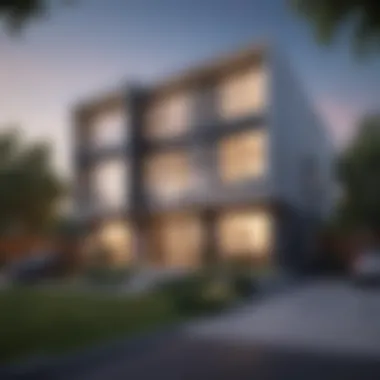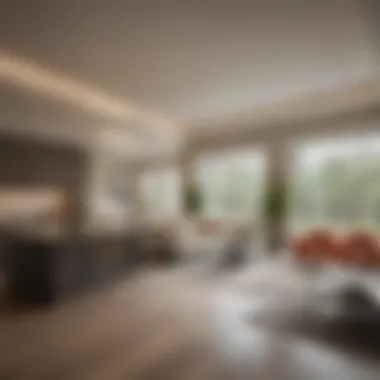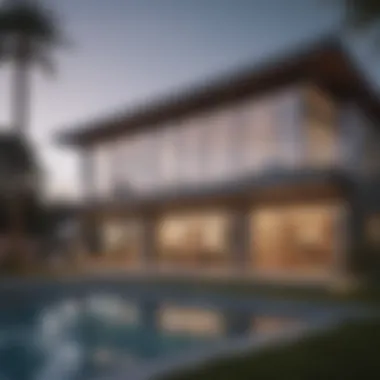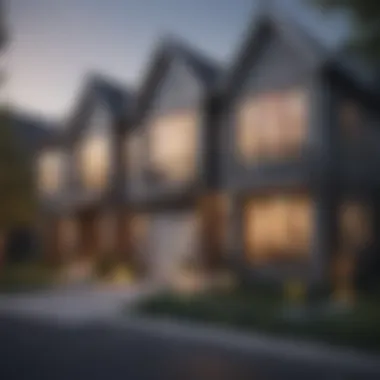Exploring the Essentials of Two-Family Duplexes


Intro
Two-family duplexes are becoming more popular in today's housing market. They offer a unique blend of advantages that cater to both homeowners and investors. Understanding what defines a duplex is crucial for those interested in this type of property. Each section will look into various aspects, including structure, benefits, and key considerations for potential buyers.
Motivations Behind Duplex Living
Individuals are drawn to duplexes due to their versatility. First, there is usually more affordability compared to single-family homes. Investors are also becoming more curious about revenue potential from rental income. Duplexes can offer this financially rewarding dual-benefit. Living in one unit while renting the other can drastically reduce housing costs.
Additionally, duplexes provide proximity to neighbors, accommodating a lifestyle where community is useful. This design is practical, especially for families that prioritize support and closeness.
Architectural Features
Duplexes typically feature two living units divided vertically, appearing as one structure. This uniform design is characterized by shared walls and often include identical layouts on each side. Such architectural design creates a duality that is both predictable and efficient.
Space Utilization
The effectiveness of space makes duplexes alluring. In most cases, each unit includes common zones assembled with convenient accessibility in mind. These can range from entryways, kitchens, and spacious living areas to private outdoor spaces. This knowledge of space allocation enhances livability.
Financial Benefits
Investing in a duplex can prove favorable economically. The option to derive income from renting is often more attractive than single-family homes. When considering real estate income, lowering monthly payments becomes crucial. Additionally, financing options may be more flexible as duplexes often qualify for different loan varieties compared to single-unit structures.
- Property appreciation typically leads to values growth over time. This appeal offers a solid investment strategy, providing leverage for financial prospects.
Zoning Insights
While duplex investments appear effortless, a thorough assessment of zoning laws is necessary. Specific areas may have restrictions affecting how duplexes are used or modified. Buyers must familiarize themselves with these regulations to ensure compliance and long-term satisfaction.
Important Note: Understanding local zoning laws is critical and can significantly influence purchasing decisions.
Lifestyle Implications
Living in a duplex brings varying lifestyle shifts. Shared wall living can spark conflict or forge strong community ties. Future duplex owners should consider how they value independence versus communal life.
Market Trends
Keeping an eye on real estate market trends is vital. Currently, duplexes thrive in urban spaces where housing demands exceed single-family supply. Research shows influx in residents seeking rental properties contributes positively to the appeal of duplex living. Investors should leverage these developments to make educated choices.
Overview of Two-Family Duplexes
Importance of Two-Family Duplexes
Two-family duplexes represent a unique and increasingly relevant segment of the real estate landscape. Their importance lies in their ability to straddle the benefits of both single-family homes and multi-family units. Individuals around the globe are challenged by rising housing costs and limited space. Here, two-family duplexes serve as a solution, providing creative living spaces that maximize value.
Investors and homebuyers should pay attention to this type of property. There is a strong gaining interest in these structures, fueled by urbanization and changing demographics. Many are drawn to the ability to generate supplementary income through rental potential, fostering a greater sense of community among neighbors.
Definition and Characteristics
A two-family duplex consists of two dwelling units that share a common wall while each unit maintains its own entrance. This design is functional, offering distinct living areas for separate households. The characteristics of these units include varied configurations, such as side-by-side or stacked layouts. Generally, duplexes come with separate utilities, enhancing the autonomy of each household.
Architecturally, duplexes are versatile. They can adapt to different aesthetics and surroundings. This adaptability is a significant factor in their appeal, allowing them to fit into diverse neighborhoods, whether urban or suburban.
Historical Context
The history of duplex dwellings traces back to the late 19th and early 20th centuries. Initially popularized during a time of rapid urban growth, the duplex model responded to a demand for affordable housing in emerging cities. Early designs often emphasized utilitarian features while maximizing available land space.
During the mid-20th century, as the population transitioned towards more suburban lifestyles, the twin-unit housing concept further evolved. Government policies began to support this residential style, underscoring the critical role duplexes could play in alleviating housing shortages. In contemporary society, duplexes have continuously adapted to shifting needs, becoming a favored option for both owners and investors seeking a profitable housing approach in urban settings.
Architectural Features
Understanding the architectural features of two-family duplexes is key to understanding their unique advantages and the lifestyle they promote. Architectural elements shape a duplex's functionality, durability, and appeal. These features enhance not just aesthetics but greatly affect living experience for the residents. Knowing these elements can aid potential buyers and homeowners assess the value and practicality of living in such structures.
Common Design Elements
Two-family duplexes share many underlying principles in their designs. The following features often recur in these buildings:
- Symmetrical Facade: Many duplexes have a balanced look with matching elements on both sides, creating a pleasing visual symmetry.
- Separate Entrances: Each unit usually has its own entrance, ensuring privacy and independence.
- Shared Walls: Duplexes often have one wall between the two living units. Sound insulation is essential here to provide comfort to residents.
- Garden or Yard Space: Many duplexes incorporate outdoor areas. Either individual or common, these spaces offer residents leisure options.
- Open Floor Plans: Inside, many duplex units opt for open designs that promote light and social interaction, aligning with modern preferences for such layouts.


These design elements not only look appealing but also foster a sense of community both in and out of these homes.
Typical Floor Plans
Floor plans of two-family duplexes can vary by design and purpose. However, typical arrangements tend to follow certain formats:
- Bi-level Plan: This includes each unit being split over two floors. The upper level often houses bedrooms while the main level contains shared living spaces.
- Single-level Living: For ease of access, especially for older inhabitants, some duplexes focus on having everything situated on one floor. It supports low-maintenance living, ideal for families and retirees.
- Side-by-Side Layout: Often units share a dividing wall, conveniently separated yet neighboring. This is a classic style seen in many suburban areas.
- Stacked Units: One unit is placed on top of the other. This is advantageous in urban settings where lot space is limited.
These Floor Plans can greatly affect home dynamics and offer flexibility for diverse family needs, making them suitable for a variety of buyers.
Exterior Considerations
The visual appeal and functionality of a two-family duplex extend to its exterior. Specific considerations include:
- Landscaping: A well-kept yard is important for both aesthetic and enjoyment purposes. It can raise the property’s curb appeal.
- Material Choices: Construction materials significantly influence durability. Brick, wood, and stucco offer different styles and resistances to weather and pests.
- Parking Facilities: Sufficient and accessible parking space is crucial for residents. Whether individual garages or communal spaces, addressing this in design is critical.
- Outdoor Amenities: Adding patios, balconies, or shared green spaces promotes quality leisure activities and enhances value.
Maintaining attention to exterior details can further enhance community feel in duplex living.
“Architectural features are not merely about aesthetics; they're fundamental in shaping the lifestyle and practicality of duplex living.”
Benefits of Two-Family Duplexes
Two-family duplexes have become increasingly relevant in today’s real estate landscape. They offer a unique combination of living arrangements that can lead to several advantages for homeowners and investors alike. With an evolving society moving towards dense urban centers and a focus on financial responsibilities, understanding these benefits is essential. This section articulates the core advantages associated with two-family duplexes, including financial incentives, potential income streams through rentals, and community-oriented lifestyles.
Financial Advantages
The financial implications of owning a duplex should not be taken lightly. Owning this type of property often means shared costs and improved financial situations for homeowners. Key reasons include:
- Lower Mortgage Payments: When two units share the same building structure, the overall costs can be divided, potentially leading to lower monthly mortgage payments.
- Decreased Utility Expenses: With both units sharing resources, utility costs can decrease.
- Equity Building: As mortgage payments are made, both owners build equity in their respective units. This increases overall financial stability.
- Investment Opportunities: Buying duplexes often proves lucrative in the long term. Owners may benefit from ongoing appreciation in value over time.
Potential for Rental Income
Duplexes offer a significant benefit through the potential for rental income. Owning a duplex presents owners the option of leasing out one unit. Key factors include:
- Steady Income Stream: Renting out the second unit provides consistent income. For many, this can contribute significantly towards their mortgage payment.
- Tenant Diversification: Having more than one tenant can lower the risk of vacancy. If unit one is empty, leasing the second can provide financial relief.
- Flexible Living Arrangements: Owners can choose to live in one unit and rent the other, creating a flexible lifestyle while tapping into income procurement.
In larger markets, rental income can cover most, if not all, of the costs associated with maintaining both units. This not only provides financial reassurance but enhances efforts in establishing financial independence through real estate.
Community and Lifestyle Benefits
Finally, two-family duplexes have benefits extending beyond mere financial possibilities. Living in close proximity to other residents enhances the overall lifestyle. Notably:
- Social Interaction: Sharing a property invites community interactions that can enrich both units’ experiences. This can enhance feelings of safety and belonging.
- Shared Amenities: Often, duplex owners on competitive urban pricing may start sharing backyard spaces, garages, or pools, enhancing life quality.
- Mutual Support: Coexisting closely creates avenues for mutual support, whether through maintenance assistance or companionship.
Together, both families can cultivate a sense of community that connects them beyond the boundaries of just two structures.
“Owning a duplex is not business alone. It is also about building connections within the community.”
The numerous benefits pertaining to two-family duplexes shape them into worthwhile considerations for potential buyers and residents today. This unique blend of investment return coupled with lifestyle advantages contributes to duplexes gaining favor in various urban areas across the country.
Considerations for Buyers
When examining the purchasing landscape of two-family duplexes, it's crucial to grasp various considerations for buyers. These factors significantly influence the long-term success and satisfaction with such a property. Buyers must navigate legal frameworks, market fluctuations, and intricate maintenance obligations to make informed choices.
Zoning and Legal Regulations
Understanding zoning and legal regulations is foundational when considering a duplex purchase. Zoning laws dictate the use of land within a particular area and significantly impact the potential modifications or uses of a duplex. Each municipality has differing regulations regarding duplex dwellings. Some regions encourage construction or renovation of duplexes to accommodate growing populations, while others feature restrictive policies aimed at maintaining neighborhood character.
Additionally, legal stipulations may influence property taxation, rental regulations, and occupants' rights. Buyers should thoroughly research:
- Local zoning ordinances
- Permitting requirements
- Property management laws
By ensuring compliance with all legal elements, potential buyers can steer clear of future issues that may arise with property usage or property value devaluation.
Market Trends and Valuation
Another significant layer in the decision-making process is the assessment of market trends and property valuation. Two-family duplexes can exhibit varied trends relative to geographic location and economic conditions. An understanding of recent market patterns, such as price appreciation or depreciation and rental demand, will provide significant insights. To effectively evaluate a duplex's potential investment value, investors should consider:
- Current sales data of similar duplex properties in the area
- Long-term growth prospects for the locality
- Trends in nearby school systems and amenities


Evaluating homicide-related patterns, demographics, and proximity to employment hubs aids buyers in projecting future value viability as well.
Maintenance Responsibilities
Maintenance responsibilities often become a crucial factor in duplex ownership. Unlike single-family homes, owners must share responsibilities, duties, and possibly burdens with another party. Foreseeing these responsibilities is vital before undertaking the purchase. The work might include:
- Exterior upkeep, ranging from lawn care to roof inspections
- Systems maintenance, such as plumbing or electrical work
- Shared areas and facilities, if available within duplex structures
It's important for investors to clarify responsibilities under common agreements and lease terms with other owners or tenants. Understanding these elements ensures expectations align and future conflicts are minimized. Thorough knowledge of each partner’s obligations can lead to sound cohabitation and ownership experience in a two-family duplex.
Maintaining clear communication between all parties ultimately retards property neglect and increases long-term equity.
By acknowledging all critical considerations before investing in two-family duplexes, buyers can make prudent decisions that align with their personal and financial goals.
Comparative Analysis
In the realm of real estate, conducting a comparative analysis between two-family duplexes and other housing options is crucial. This scenario helps potential buyers and investors understand the unique advantages and limitations associated with duplex living. It gives insight into market niches, financial outlays, and lifestyle choices.
Duplex vs.
Single-Family Homes
When we contrast duplexes with single-family homes, the difference comes down to character requireding lifestyles. A single-family home offers independence and privacy. However, it typically carries higher costs for maintenance and taxes. On the other hand, a duplex presents shared expenses. This can lead to a more manageable financial scenario.
A few key considerations should be highlighted:
- Maintenance Responsibilities: Duplexes may distribute maintenance costs and errands across units.
- Financial Investment: With duplexes, copying doing both renting one unit and living in the other can supplement owners' income.
- Community Vibes: Duplex settings often lead to a stronger connection between neighbors.
Potential negative aspects of duplexes might include shared noise and little privacy.
Duplex vs.
Multi-Family Units
Contrasting duplexes with multi-family residential options further complicates the real estate harmony. Multi-family units include apartment buildings that house many separated units. These options tend to offer greater population density and are often found in urban centers.
The efficacy of multi-family units has evident draws:
- Higher Income Pressure: Potential income often should be better due to more renting units in one area.
- Property Management Needs: Multi-family units usually need professional management for logistics and upkeep, raising costs.
- Investment Risk: Market can fluctuate more intensively for multi-family configurations.
Nevertheless, duplexes strike outas they provide both independence and portable opportunities found in shared living atmospheres compared to transfers found at a multi-family unit accommodation.
The comparative analysis of duplexes highlights interesting investment opportunities, income considerations, and lifestyle choices that buyers highly take advantage when seeking housing options.
Investment Potential
Investment in real estate is often seen as one of the most stable ways to build wealth. Duplexes, particularly two-family structures, offer a versatile medium for investors looking to maximize their returns. This section will delve into not just the potential of duplex investments but also the specific benefits and considerations that make them appealing.
Long-Term Investment Strategies
Long-term investment strategies in two-family duplexes are advantageous for several reasons. Owning a duplex can generate repeated income over time, especially when one side of the duplex is rented out. This continual cash flow helps to cover mortgages and maintenance costs.
Moreover, duplexes often see appreciation in value. Over the years, the neighborhoods where duplexes are located may become more desirable, driving up property values. Investors can take a systematic approach:
- Purchase in Gentrifying Areas: Look for neighborhoods that are undergoing revitalization. Buying in these areas early can yield significant returns.
- Continuous Upgrades: Making regular improvements can differentiate your property and keep up with market standards.
- Maintain a Diverse Portfolio: Consider diversifying property types. A mix of residential and commercial may bring stable returns.
Establishing a clear strategy and continually monitoring the situation provides investors the best chance for success.
Understanding Local Real Estate Markets
Understanding the peculiarities of local real estate markets is critical for successful duplex investment. Every market operates differently, influenced by a range of factors such as local economy, demographic trends, and zoning regulations.
To make informed moves, investors should:
- Research Local Trends: Look beyond basic statistics to understand what drives demand in the area.
- Attend Open Houses and Auctions: These events provide insight into what properties attract buyers.
- Network with Local Agents: Agents are knowledgeable about neighborhoods and often know opportunities before they hit the market.
Each investment should be seen as a unique opportunity. Evaluating local data allows prospective investors to navigate risks better and foresee potential rewards, thus empowering informed decisions in the competitive real estate landscape.


Investing in a duplex not only serves as a source of personal residence but also functions effectively as an income generator, particularly in learning depicted market dynamics.
Case Studies and Success Stories
Understanding successful ventures in the context of two-family duplexes offers invaluable insights for prospective buyers and existing owners. Case studies and success stories illustrate practical applications and illustrate the benefits these properties can provide. They shine a light on real-world examples, showcasing how habitation of duplexes fosters community engagement and financial rewards. They also highlight typical challenges, and design innovations emerged during the process, which can inform others considering a similar path.
Successful Duplex Conversions
Successful duplex conversions typically involve transforming a single-family residence into two separate living spaces. These transformations often occur in urban or suburban areas where market demand pushes the boundaries of traditional layouts. Owners and developers must consider local regulations, building codes, and design while maintaining a living environment suitable for two families.
For instance, a notable case involved converting a historic single-family home in a desirable neighborhood. The existing structure’s design elements were preserved while altering the floor plan to create two self-sufficient units. As a result, both apartments retained their historic charm and improved the overall value of the property. Financially, the owner achieved an impressive return by renting out one unit for income while residing in the other, thus maximizing space utilities.
After renovations, many conversions have resulted in increased property values, enhancing neighborhoods and simultaneously increasing local housing stock. Besides, case studies often reflect that successful duplexes can lead to strong rental demand.
Interviews with Owners
Conducting interviews with duplex owners grants a closer look at their personal experiences with their properties. These conversations reveal diverse perspectives on life in two-family homes whilst highlighting practical considerations.
Owners commonly point out the importance of communication, especially in shared settings. Open dialogue can prevent disputes, ensuring a harmonious living situation. Many residents also tout the significant financial benefits of owning a duplex, often discussing how rental income pays off mortgages or funding renovations.
Themes from these interviews might include:
- The balance between privacy and community living.
- The impact of property modifications on both units.
- Real estate trends which owners notice as the market shifts.
Participants may also note their motivations behind investing in duplexes, as each story underscores the blend of financial logic and lifestyle adjustments.
Rich insights from case studies and direct voices enhance the understanding of duplex living and inform potential buyers and investors about realistic outcomes associated with this housing form.
Future of Duplex Living
The future of duplex living represents a compelling intersection of evolving lifestyle preferences and economic realities in today's housing market. As urban areas increase in population density, two-family duplexes are becoming more desirable due to their efficient use of space and adaptability. People are re-evaluating what they need in a home, balancing the desire for privacy with the benefits of close community ties. Duplexes offer a unique remedy to this need, highlighting their importance in contributing valuable solutions to modern residential demands.
Emerging Trends in Duplex Design
Current trends in duplex design are dictated by several factors: cultural shifts, climate change, and technological advances. Residential architects are increasingly making spaces dual-purpose to support flexible living.
A shift towards simpler elegance is emerging, with open floor plans encouraging sociability while still maintaining distinct living areas. Features such as larger windows and balconies are being integrated to enhance natural light and outdoor connections, reinforcing that dual units can offer spacious luxury rather than a cramped experience. Considerations for noise reduction between units have also gained attention, resulting in the implementation of soundproofing materials and layouts that minimize disturbances.
- Key considerations in modern duplex breeding grounds include:
- Mix of traditional and contemporary elements for visual appeal
- Energy efficiency through better insulation and sustainable materials
- Smart-home technologies ensuring comfort and energy management
As duplex living continues its evolution, municipalities must also adapt zoning laws to coincide with innovative designs. Through understanding emerging guidelines, owners have greater access to the benefits that duplex living has to offer.
Sustainability Considerations
Sustainability is no longer a buzzword—it is a prerequisite in the design and construction of modern duplexes. This has taken shape through environmentally friendly materials that significantly reduce a building's carbon footprint. The integration of green spaces, rainwater harvesting systems, and energy-efficient appliances are encouraged practices, indicating a heightened attention to holistic living.
Moreover, the concept of sharing livable space is particularly valuable in urban settings. Duplex residents benefit from shared resources while minimizing individual environmental impacts. Leading designs foster ecological compatibility while promoting wellness for communities.
- Here are essential points:
- Use of solar panels reduces long-term utility costs.
- Rain gardens improve water management and enhance local flora.
- Energy-efficient appliances contribute to lower energy bills and less waste.
By owning a duplex, residents have a responsibility to think down the road towards scalable living options. Choices made today regarding sustainability in duplex living have ripple effects on global environmental practices, ultimately guiding how future generations will occupy and inhabit communal spaces.
Adapting to the future goes beyond architecture; it is a mindset rooted int innovations and sustainability.
Ending
Understanding the topic of duplex living has grown increasingly vital as urban areas expand and housing needs evolve. This article shed light on the multiple dimensions of two-family duplexes, which cater to varied lifestyles and investment strategies. It is crucial to understand the structure of duplexes. They offer a blend of privately owned space alongside shared community benefits.
Summary of Key Insights
- Two-family duplexes provide homeowners a unique design that incorporates private living with the advantages of shared space.
- Financial structures of duplexes allow for potential rental income, making them attractive for investors.
- Zoning regulations play a crucial role in defining what property owners can achieve, requiring careful consideration before any investment.
- Maintenance needs often require cooperation between units, promoting a distinct community dynamic unlike that of single-family homes.
Duplex living is more than mere architecture; it embodies a new way of life, combining innovation and efficiency.
Ultimately, thoughtful examination of duplex practicalities reveals valuable benefits. Ingredients such as community connectivity and financial foresight establish duplexes as a smart housing choice while bringing lifestyle conveniences often overshadowed by larger family homes.
Final Thoughts on Duplex Living
In closing, duplex living offers an attractive alternative for buyers and investors who seek a combination of affordability and social interaction. The benefits discussed paint a promising picture of urban living as not just practical housing but also a pathway to community connection. Such insights can encourage potential new residents to explore, adapt, and embrace the charm and versatility of duplex homes. Understanding these factors enhances decision-making for any potential homeowner in the realm of increasingly crowded cities. Therefore, as we progress, duplexes will likely continue asserting their importance in real estate market landscapes, especially in accommodating diverse housing needs.



